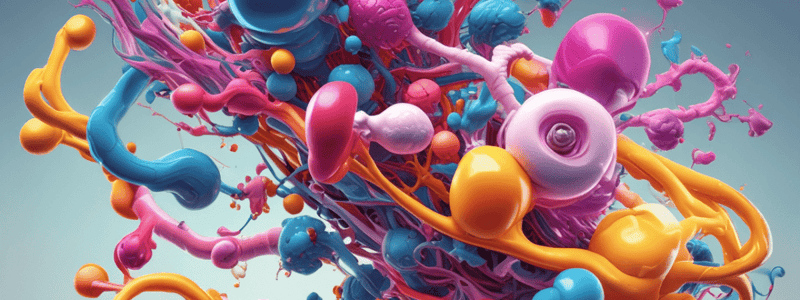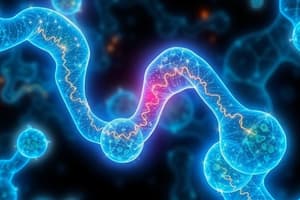Podcast
Questions and Answers
What percentage of energy used during ATP production creates heat?
What percentage of energy used during ATP production creates heat?
- 60% (correct)
- 50%
- 80%
- 70%
Which of the following is NOT a mode of heat transfer mentioned in the text?
Which of the following is NOT a mode of heat transfer mentioned in the text?
- Absorption (correct)
- Conduction
- Radiation
- Convection
What percentage of heat is lost through radiation in a naked human?
What percentage of heat is lost through radiation in a naked human?
- 3%
- 60% (correct)
- 20%
- 15%
Which of the following is NOT a factor contributing to the Basal Metabolic Rate (BMR)?
Which of the following is NOT a factor contributing to the Basal Metabolic Rate (BMR)?
How many calories are equivalent to one pound of fat?
How many calories are equivalent to one pound of fat?
Which of the following vitamins is fat-soluble?
Which of the following vitamins is fat-soluble?
Which type of reaction involves producing larger molecules using the energy from catabolism?
Which type of reaction involves producing larger molecules using the energy from catabolism?
In carbohydrate metabolism, what happens to pyruvate if oxygen is present?
In carbohydrate metabolism, what happens to pyruvate if oxygen is present?
Which hormone is primarily anabolic in its metabolic effects?
Which hormone is primarily anabolic in its metabolic effects?
What is the primary function of the electron transport chain in cellular metabolism?
What is the primary function of the electron transport chain in cellular metabolism?
What is the process of creating glucose in the liver from non-carbohydrate precursors called?
What is the process of creating glucose in the liver from non-carbohydrate precursors called?
In lipid metabolism, what role does cholecystokinin (CCK) play?
In lipid metabolism, what role does cholecystokinin (CCK) play?
What is the primary purpose of ketone bodies in metabolism?
What is the primary purpose of ketone bodies in metabolism?
How are excess amino acids typically dealt with in the body?
How are excess amino acids typically dealt with in the body?
What is the primary metabolic state when the body is digesting and absorbing food, with anabolism exceeding catabolism?
What is the primary metabolic state when the body is digesting and absorbing food, with anabolism exceeding catabolism?
Why is nitrogen processed through the urea cycle when dealing with excess amino acids?
Why is nitrogen processed through the urea cycle when dealing with excess amino acids?
Flashcards are hidden until you start studying




